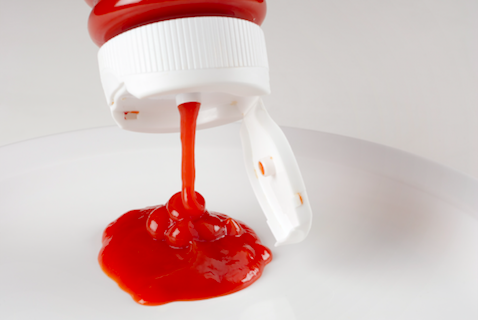
July 01, 2021
 Source/Image licensed from Ingram Image
Source/Image licensed from Ingram Image
Ketchup is among various common foods with surprisingly high amounts of sugar. One tablespoon has four grams of sugar.
It's no secret that consuming too much sugar increases the risk of myriad health issues, including obesity, heart disease, fatty liver disease and type 2 diabetes. But many people struggle to reduce their intake.
Most people know that soda, ice cream and candy bars are loaded with sugar. Yet, they may not know that many processed foods and beverages also have added sugars. Many people also add sugar when they are cooking and baking.
In 2020, the U.S. Food and Drug Administration started requiring food manufacturers to list added sugars as well as total sugars, which can help consumers be more discerning when choosing products. However, many consumers are still confused by nutrition labels.
Consumers also can get a sense of a food's sugar content by scanning the ingredient list for alternative names, nutrition experts say.
Any of the following ingredients indicate a food has added sugar: agave nectar, brown sugar, cane juice, corn sweetener, date sugar, dextrose, fruit juice concentrate, fructose, honey, lactose, barley malt, maltose, molasses, raw sugar, sucrose, sweetened carob powder, treacle, turbinado sugar, high fructose syrup. The same is true of can, corn, golden malt, maple and rice syrups.
"There are also natural sweeteners such as honey, pure maple syrup," Dr. Amy Lee, chief medical officer of Lindora Clinic in Southern California and an expert in weight control, obesity and nutrition, told PhillyVoice. "If you see these on an ingredients list, these are still classified as added sugar."
The American Heart Association recommends women consume no more than 6 teaspoons of sugar each day, the equivalent of about 24 grams or 100 calories. For men, the recommendation is 9 teaspoons, about 36 grams or 150 calories.
Added sugar — not the naturally-occurring sugars found in whole foods, like fruits and vegetables — is the big culprit behind America's sugar addiction, experts say.
In whole foods, the effects of the sugar are modified by fiber and antioxidants that improve the way the body breaks down sugar. Because of this, people don't experience a blood-sugar spike. Added sugars, on the other hand, are simply empty calories.
The average American adult eats 22 teaspoons of sugar a day. To cut down to the recommended level is a drastic change – it takes knowledge and commitment, Lee said.
"You need to have motivation to commit to a new lifestyle," she said. "You need to be able to commit to a low carb and sugar diet."
While all sugars can't be avoided, here are 13 food and drinks that many people do not realize are high in sugar.
1. Yogurt
Low fat yogurt can be a healthy snack, but it depends on whether it has added sweeteners that amp up the sugar content. Most yogurts have 6 to 9 grams of natural sugar, but some sweetened versions will have more than 20 grams of total sugar per cup.
2. Sauces
Sriracha, ketchup, BBQ sauce and salad dressings may seem like a harmless addition to enhance the taste of a meal, but they all have added sugars that can quickly add up – even when people think they are just using a little bit.
One teaspoon of Sriracha contains one gram of sugar. One tablespoon of Heinz Ketchup contains four grams of sugar. A tablespoon of BBQ sauce has at least 4-6 grams of sugar. Two tablespoons of light or fat-free salad dressing have six grams of sugar.
3. Fruit juice
Even 100% fruit juice with no added sugar has sugar. This is because it takes a lot of fruit to make juice, nutritionists say. One 6 oz. box of orange juice can contain 18 grams of sugar.
4. Spaghetti sauce
It is best to make spaghetti sauce to avoid added sugars, nutritionists say. Just one cup of a pre-made version can contain 2.5 teaspoons of sugar.
5. Sports drinks
A 32-ounce sports drink contains between 56 and 76 grams of sugar – four to six times the recommended daily amount for kids and teenagers, according to the University of Iowa Stead Family Children's Hospital. So even though they are marketed as a healthy way to rehydrate after working out, water is the healthier choice.
6. Protein bars
Protein bars are another snack that many people would consider healthy, but many have added sweeteners, like honey. Nutritionists recommend that people chose protein bars that have no more than 13 grams of sugar.
7. Pre-made soups
Soups are healthier when made from scratch, because people can control what goes into them. The pre-made versions often have added sugar for taste. A can of tomato soup can have 20 grams of added sugar, equivalent to five teaspoons, according to Today.com.
8. Breakfast cereal
Even cereals marketed as healthier alternatives, like Honey Bunches of Oats, can contain brown sugar, corn syrup, honey or just plain sugar. One 12-ounce serving could have up to 3 teaspoons of sugar.
9. Canned fruit
Canned fruits often are preserved in sugary syrup, so consumers are advised to be careful when buying them. A half-cup serving of canned slice peaches can have 21 grams of sugar.
10. Peanut butter
Many people don't read labels and assume peanut butter is just peanuts, Lee said. But most peanut butter products have added sugar too. Peanut butter naturally contains about 1 to 2 grams of sugar, but look for added sugars on the label and molasses and corn syrup within the ingredients list.
11. Bread
Carbohydrates also contribute to sugar intake. According to the USDA National Nutrient Database, one slice of commercially-prepared white bread has 1.4 grams of sugar.
12. Frozen dinners
The Cleveland Clinic warns that frozen foods also can be a hidden sugar trap. Their dietitians advise reading labels carefully for sugars such as agave nectar, fruit juice concentrate, honey and maltodextrin syrup.
13. Dried fruit
Although dried fruits are healthy, they have more concentrated sugar because most of the water content has been removed, Healthline reports. Dried raisins are 59% sugar naturally. Dates are about 66% sugar. Nutritionists recommend people choose dried fruit that does not have any added sugar.
Reading labels can be tricky, even with the FDA updates, Kimberly Gomer, director of nutrition at Pritikin Longevity Center & Spa in Florida, told PhillyVoice.
The best way for people to know what they are consuming is to look closely at the ingredient list, she advises. All ingredients must be listed by weight, so the first four ingredients typically make up the bulk of the product. If a type of sugar is in one of these top spots, the food has a high sugar content.
Less expensive products have more sugars and other preservatives because sugar is cheap and tastes good, Lee added. This has led to the country's sugar addiction. Many people have trouble shutting down their craving for sugary foods.
The best thing people can do for their health is to eat a high-fiber diet, exercise and lose belly fat, Gomer said.
People who are trying to cut sugar are advised to have a doctor or a nutritionist tailor a nutrition plan that fits their particular health needs. Everyone's sugar goals are individualized. People who are more active and mostly eat a plant-heavy diet have more room for treats, Gomer said.
When people are insulin-resistant, even natural sugars can be problematic.
"Some people are more sensitive to sugar than others – insulin-resistant people don't do well with any type of sugar," Gomer said. "One hundred million people in the U.S. are insulin resistant."
Insulin resistance is when the body can't use glucose from the blood properly for energy. The condition often leads to prediabetes and type 2 diabetes, if it isn't reversed.
While it isn't clear what causes the condition, being overweight (especially around the middle), a family history of type 2 diabetes and inactivity are all considered risk factors, according to the U.S. Centers for Disease Control and Prevention.
For people who are insulin resistant, even a healthy snack of grapes could spike their blood sugar, causing brain fog and fatigue. When insulin-resistant, it is important to limit the sugar in whole foods, not just added sugars.
For instance, Gomer said berries would be a healthier choice for an insulin-resistant person because they have less sugar than fruits like grapes, bananas and mangos.